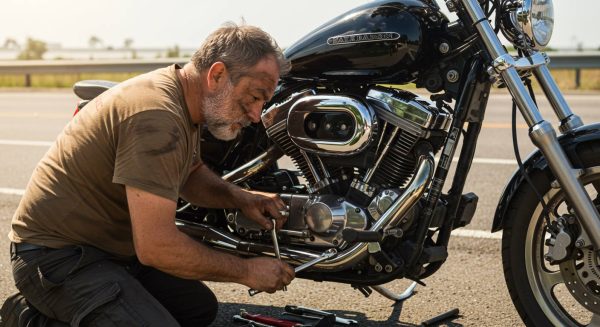While motorcycles don’t break down more frequently than cars when properly maintained, their exposure to the elements and vibration can make them more susceptible to certain issues. The National Standard emphasises the importance of being prepared for unexpected mechanical problems. Understanding basic emergency repairs and having appropriate breakdown cover can mean the difference between a minor inconvenience and a major ordeal.
Essential Emergency Equipment and Lighting
The guidance stresses the importance of proper emergency lighting equipment. Your motorcycle’s hazard warning lights are your first line of defence when experiencing mechanical issues. The standard requires that riders know how and when to use these emergency lights effectively, particularly in poor visibility conditions or when stopped in a vulnerable position.
Common Breakdown Scenarios and How to Handle Them
The standard outlines several key steps to take during a breakdown:
- Move to a safe place if possible, ideally off the main carriageway
- Switch off the engine
- Activate hazard warning lights immediately
- Keep pillion passenger safe and away from traffic
- Call for professional assistance from a position of safety
Choosing the Right Motorcycle Breakdown Cover
While not explicitly covered in the standard, breakdown cover is a crucial consideration for any rider. Different policies offer varying levels of protection, from basic roadside assistance to comprehensive coverage, including:
- Home start services
- Recovery to a destination of your choice
- Alternative transport arrangements
- Emergency accommodation if needed
Emergency Roadside Repair Skills
The standard recommends that riders understand basic emergency repairs. While you shouldn’t attempt complex repairs roadside, knowing how to perform basic checks and fixes can be invaluable. This includes checking:
- Drive chain tension
- Basic electrical connections
- Fuel system issues
- Tyre pressure and condition

Location Awareness During Breakdowns
The guidance specifically addresses motorway breakdowns, recommending the use of emergency roadside telephones over mobile phones. These phones are directly linked to highway agencies and provide exact location information. For non-motorway situations, being able to accurately describe your location to recovery services is crucial.
Preventive Measures to Avoid Breakdowns
The standard emphasises preventive maintenance as the best defence against breakdowns. Regular checks and servicing can identify potential issues before they leave you stranded. This includes monitoring:
- Oil levels and condition
- Chain lubrication and adjustment
- Tyre wear and pressure
- Battery condition
- Electrical system operation
Emergency Communication and Safety
When experiencing a breakdown, clear communication is essential. The standard advises:
- Using hazard warning lights to alert other road users
- Wearing high-visibility gear when dealing with a breakdown
- Keeping emergency contact numbers readily available
- Having a fully charged mobile phone for emergencies
Professional Support and Recovery Options
The guidance recognises that some situations require professional intervention. It’s important to:
- Have access to emergency repair services
- Know your breakdown cover details
- Understand when a repair is beyond roadside fixing
- Have a plan for motorcycle recovery if needed
Remember, while mechanical issues can be frustrating, safety should always be your primary concern. Position yourself and your motorcycle safely, make yourself visible to other road users, and don’t attempt repairs that could put you at risk. With proper preparation and the right coverage, most breakdown situations can be managed safely and efficiently.
